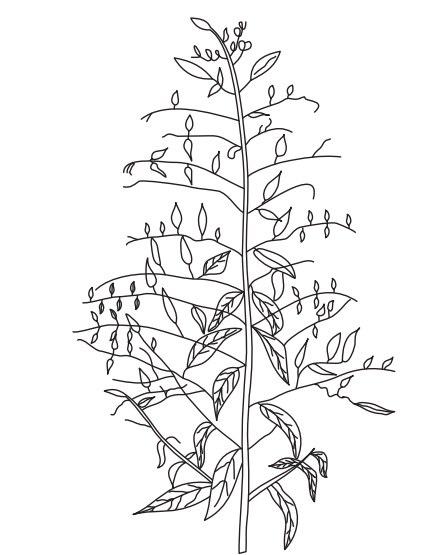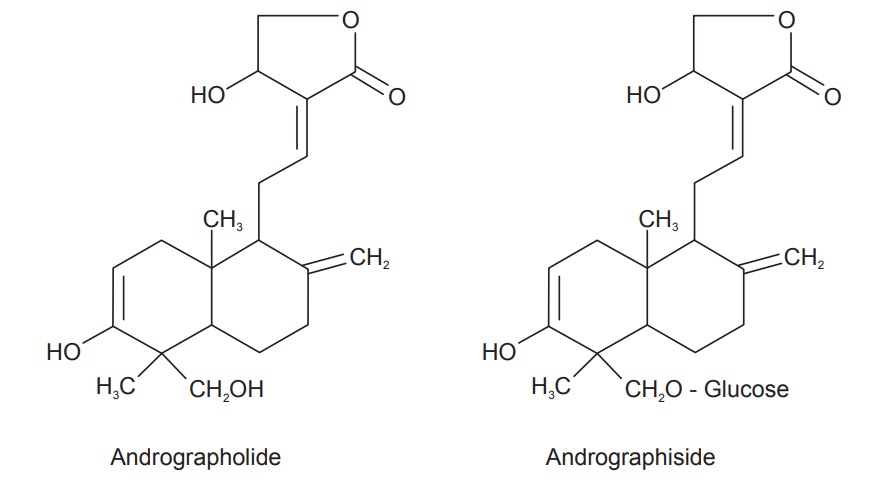Kalmegh
| Home | | Pharmacognosy |Chapter: Pharmacognosy and Phytochemistry : Drugs Containing Glycosides
Kalmegh consists of leaves or entire aerial part of Androgra-phis paniculata Nees., belonging to family Acanthaceae.
KALMEGH
Synonyms
Andrographis, King of bitters, Chiretta; Bengal Chirata; Green
Chirata; Kiryet (Hindi).
Biological Source
Kalmegh consists of leaves or entire aerial part of Androgra-phis paniculata Nees.,
belonging to family Acanthaceae.
Geographical source
It grows abundantly in southeastern Asia: India (and Sri
Lanka), Pakistan and Indonesia but it is cultivated extensively in China and
Thailand, the East and West Indies, and Mauritius.
Cultivation and Collection
It is normally grown from seeds ubiquitously in its native
areas where it grows in pine, evergreen and deciduous forest areas, and along
roads and in villages. In India, it is cultivated during rainy phase of summer
season (Kharif) crop. Any soil having fair amount of organic matter is suitable
for commercial cultivation of this crop. About 400 g seed are sufficient for
one hectare. The spacing is maintained 30 × 15cm. No major insect and disease
infestation has been reported. The plants at flowering stage (90–120 days after
sowing) are cut at the base leaving 10–15cm stem for plant regeneration. About
50–60 days after first harvest, final harvest is performed. In Indian
condition, the yield varies between 2,000–2,500 kg dry herb/hectare.
Characteristics
The stem is erect, greenish brown, woody, 30–100 cm in
height, and quadrangular particularly in the upper regions with four bulges
arising on the four corners. The leaves are dark green, lanceolate, with a
small winged petiole, 7 cm long, 2–5 cm broad; margin is entire, lamina
glabrous, apex acuminate, slightly waxy and base tapering. The midrib varies in
outline at different regions of the leaf. Stem branching is profuse which bears
small arid solitary flowers. The dried drug is odourless and taste is extremely
bitter.

Chemical Constituents
The plant possesses kalmeghin, a bitter crystalline
diterpene lactone, such as, andrographolide flavonoids and phenols. The
lactones isolated from Kalmegh are andrographolide,
14-deoxy-ll-oxo-andrographolide, 14-deoxy-11, 12-didehydroandrographolide,
14-deoxyandrographolide and neoandrographolide.
The leaves contain β-sitosterol glucoside, caffeic,
chlorogenic and dicaffeoyl-quinic acids, carvacrol, eugenol, myristic acid,
hentriacontane, tritriacontane, oroxylin A, wogonin, andrograpanin,
14-deoxy-12-methoxyandrogra-pholide, andrographidines A-F and stigmasterol.

Uses
Kalmegh has febrifuge, tonic, alterative, anthelmintic,
astringent, anodyne, alexipharmic and cholagogue properties. It is useful in
debility, cholera, diabetes, swelling, itches, consumption, influenza, piles,
gonorrhoea, bronchitis, dysentery, dyspepsia, fever and in weakness. A
decoction of the plant is used as a blood purifier and as a cure for torphid
and jaundice. The pills prepared from macerated leaves and certain spices (e.g.
Cardamom, Clove and Cinnamon) are given for stomach ailments of infants.
Marketed Products
It is one of the ingredients of the preparations known as
Purim, Acene-n-pimple cream (Himalaya Drug Company), Herbohep (Lupin Herbal
Laboratory), Sage Liverex (Sage Herbals) and Puridil syrup (Aimil
Pharmaceuticals).
